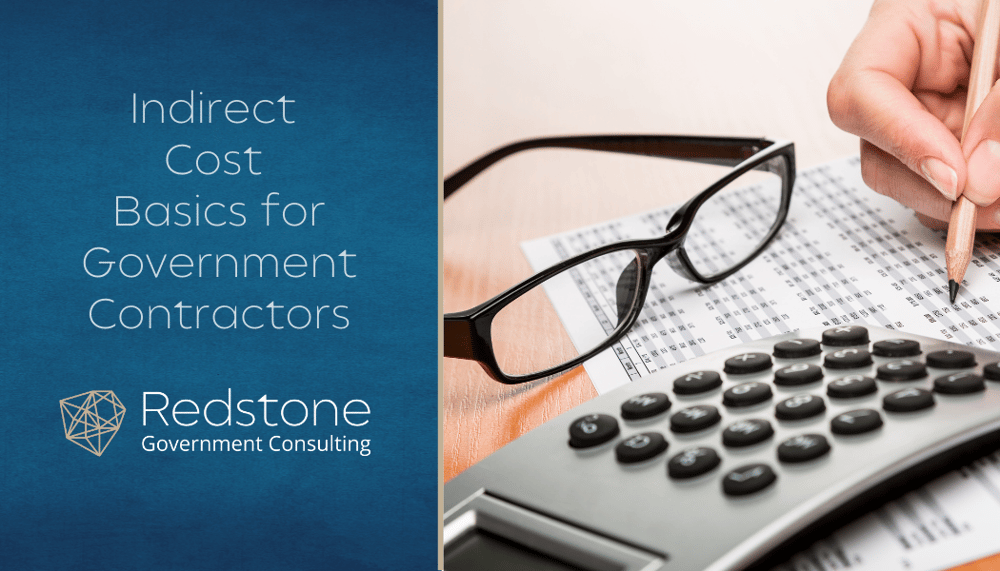
FAR Subpart 2.1, Definitions, provides the meaning of two general groupings of cost not assignable directly to final cost objectives (i.e., not a direct contract cost):
- “Indirect cost” means any cost not directly identified with a single final cost objective, but identified with two or more final cost objectives or with at least one intermediate cost objective.
- “General and administrative (G&A) expense” means any management, financial, and other expense which is incurred by or allocated to a business unit and which is for the general management and administration of the business unit as a whole. G&A expense does not include those management expenses whose beneficial or causal relationship to cost objectives can be more directly measured by a base other than a cost input base representing the total activity of a business unit during a cost accounting period.
Indirect Cost Grouping - Pools
The term overhead is often used to refer to indirect cost, including G&A. Indirect cost is not identifiable with a single cost objective or contract. Therefore, you must have a cost accounting practice in place to collect and allocate these costs. Collecting or grouping these costs is done using indirect cost pools. Many contractors set up their accounting system so that these pools are easily identifiable, for example, creating a series of accounts specific to a particular overhead pool (i.e., all 6000 accounts represent costs of the manufacturing overhead pool). By taking this approach, cost associated with this overhead pool, such as depreciation for equipment on the manufacturing floor, can be charged/booked to the 6200, Depreciation, expense account. At the end of the accounting period a report can be run, totaling all cost in the 6000 series accounts; you then have your manufacturing overhead pool (indirect cost pool) without having to review individual transactions.
Allocating Indirect Cost Pools
Now that we have the pool costs collected, we need to allocate them to contracts. FAR 31.201-4, Determining allocability, provides guidance on how a cost should be allocated to one or more cost objectives based on relative benefits received. An indirect cost is allocable to a contract if it benefits more than one contract and can be distributed in reasonable proportion to the benefits received, or is necessary to the overall operation of the business (G&A), although a direct relationship to any particular cost objective cannot be shown. To accomplish the allocation, an indirect cost rate is developed. An indirect cost rate is a percentage or dollar factor that expresses the ratio of indirect expense incurred during the accounting period to direct labor cost, manufacturing cost, or another appropriate base.
Selecting an Allocation Base
While the FAR allows for a large selection of potential base costs, most contractors use direct labor costs to allocate indirect costs to contracts. The reason for the use of a directly labor cost base is because it is easily accounted for in the accounting system and, in most cases, a large amount of the indirect cost is either caused by or a benefit to employee labor cost.
While FAR part 31 mentions G&A in several areas, it does not require the contractor to have a G&A rate. For many smaller contractors, having a single indirect cost rate (which includes G&A type expenses) is adequate, as there is no significant misallocation of cost to contracts. Once a contractor becomes full CAS covered, a G&A rate is required.
Consistency = Indirect Cost Success
Once you establish your indirect cost rate structure there are two key things to remember. You need to be consistent. This means estimating and allocating indirect cost in proposals in the same way actual indirect cost are allocated to all contracts (both Government and Commercial). This also means that contractors should limit changes to their indirect rate structure based on individual proposals they are submitting (i.e., you should not change your structure for each contract awarded) Granted, changes in indirect rate structures are sometimes warranted, due to changes in business base or changes in the types of services or products delivered, but constant modification to the indirect rate structure is bad practice.
Don’t Forget Unallowable Costs
Another key factor for contractors is the need to properly account for unallowable costs. Unallowable costs are those for which the government will not reimburse a contractor. Unallowable costs are defined in FAR Part 31 as any cost that, under the provisions of any pertinent law, regulation or contract, cannot be included in prices, cost-reimbursements or settlements under a Government contract to which it is allocable. Therefore, unallowable cost must be removed from the indirect cost pool before the rate is calculated. However, should those pool costs be part of a base to allocate another indirect cost pool the unallowable cost must remain in the base to calculate that rate. In our experience, the inclusion of unallowable cost in a base for a pool can be confusing to contractors. RGCI has extensive experience in assisting contractors through this process.
Redstone GCI assists contractors throughout the U.S. and internationally with understanding the Government’s expectations and requirements for developing an indirect rate structure that complies with FAR and CAS, if applicable. Our team of experts not only advises contractors on compliance issues associated with indirect rate structures, but we also assist with strategies and approaches for enhancing and restructuring contractor’s indirect rate structures to become more competitive and attain a greater recovery of indirect cost.


 John is a Director with Redstone Government Consulting, Inc. providing government contract consulting services to our clients primarily related to the DFARS business systems, CAS Disclosure Statements, and DCAA/DCMA compliance preparation, advisory, and defense. Prior to joining Redstone Government Consulting, John served in a number of capacities with DCAA/DCMA for more than 30 years. Upon his retirement, he was based in Texas as an SES-level Corporate Audit Director for DCAA, managing a staff of 300 auditors at one of the largest DOD programs. Professional Experience John began his career in the late 80s working in the Clearwater, FL audit office and over the next three decades he progressed through a number of positions within both DCAA and DCMA with career highlights as DCAA Program Manager at Ft. Belvoir, Chief of Technical Programs Division, Deputy Assistant Director-Policy, Director of the DCMA Cost and Pricing Center, the SES-level Lockheed Martin Corporate Audit Director, and Director of Integrity and Quality Assurance. John’s three decades of experience in performing and leading DCAA auditors and DCMA reviewers provides a wealth of expertise to our clients. John’s role, not only in the performance of audits, but also in the development of audit policy affords him unique insights into the defense of audit findings and the linkage of audit program steps to the underlying regulatory framework. He is an expert in FAR, DFARS, and other agency acquisition regulation, as well as a subject matter expert in the Cost Accounting Standards having reviewed and provided audit feedback on many of the largest and most complex cost accounting practices during his tenure with the DCAA. John’s tenure with DCAA and DCMA came at a critical time during each agency’s history where a number of changes were occurring such as the response to the ICS backlog, development of audit approaches to the DFARS Business Systems and implementation of new audit initiatives as a result of Congressional oversight through the NDAA process. John’s leadership at the DCMA Cost & Pricing center saw oversight of all major DOD pricing actions, leadership of should cost review teams, the Commercial Pricing group and many other areas of strategic value to our clients. His involvement in these and other Agency initiatives is of great value to our clients due to his in depth understanding of DCAA and DCMA’s internal policy directives. Education John holds a Master of Business Administration and a B.A. in Accounting from the University of South Florida. Certifications Certified Information Systems Auditor State of Alabama Certified Public Accountant
John is a Director with Redstone Government Consulting, Inc. providing government contract consulting services to our clients primarily related to the DFARS business systems, CAS Disclosure Statements, and DCAA/DCMA compliance preparation, advisory, and defense. Prior to joining Redstone Government Consulting, John served in a number of capacities with DCAA/DCMA for more than 30 years. Upon his retirement, he was based in Texas as an SES-level Corporate Audit Director for DCAA, managing a staff of 300 auditors at one of the largest DOD programs. Professional Experience John began his career in the late 80s working in the Clearwater, FL audit office and over the next three decades he progressed through a number of positions within both DCAA and DCMA with career highlights as DCAA Program Manager at Ft. Belvoir, Chief of Technical Programs Division, Deputy Assistant Director-Policy, Director of the DCMA Cost and Pricing Center, the SES-level Lockheed Martin Corporate Audit Director, and Director of Integrity and Quality Assurance. John’s three decades of experience in performing and leading DCAA auditors and DCMA reviewers provides a wealth of expertise to our clients. John’s role, not only in the performance of audits, but also in the development of audit policy affords him unique insights into the defense of audit findings and the linkage of audit program steps to the underlying regulatory framework. He is an expert in FAR, DFARS, and other agency acquisition regulation, as well as a subject matter expert in the Cost Accounting Standards having reviewed and provided audit feedback on many of the largest and most complex cost accounting practices during his tenure with the DCAA. John’s tenure with DCAA and DCMA came at a critical time during each agency’s history where a number of changes were occurring such as the response to the ICS backlog, development of audit approaches to the DFARS Business Systems and implementation of new audit initiatives as a result of Congressional oversight through the NDAA process. John’s leadership at the DCMA Cost & Pricing center saw oversight of all major DOD pricing actions, leadership of should cost review teams, the Commercial Pricing group and many other areas of strategic value to our clients. His involvement in these and other Agency initiatives is of great value to our clients due to his in depth understanding of DCAA and DCMA’s internal policy directives. Education John holds a Master of Business Administration and a B.A. in Accounting from the University of South Florida. Certifications Certified Information Systems Auditor State of Alabama Certified Public Accountant